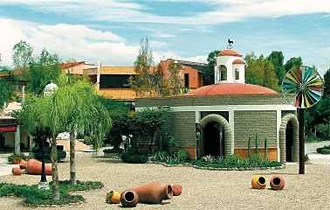
|  |  |  Vallarta Living | December 2008 Vallarta Living | December 2008  
Consider Retirement Options in Mexico
 Laurence Iliff - McClatchy-Tribune Laurence Iliff - McClatchy-Tribune
go to original


| | Cielito Lindo is a new assisted-living development outside San Miguel de Allende, Mexico, that charges about a third of what care and meals would cost in the United States. (McClatchy-Tribune) |  |
With 75 million American baby boomers heading toward retirement and the cost of private nursing care in the U. S. outstripping hammered retirement funds, Mexican developers say they have an irresistible product in the works: active senior and assisted- living facilities in a warm climate full of friendly people for as little as $1,100 a month.

Some developers are shifting their traditional condo and townhouse developments midstream to include assisted- living wings focused, in part, on Americans who want modern facilities with quality services at reasonable prices.

There are already an estimated 1.2 million retired Americans and Canadians in Mexico.

“This is not going to be a niche market; this is going to be an entire industry,” said Eduardo Alvarado, chief executive officer of La Moreleja, a residential development in San Luis Potosi, a colonial city in northern Mexico that also sports Wal-Mart, Home Depot and many other businesses familiar to Americans.

“We already have the pioneers here, but what we are seeing is that many people will come — perhaps not because they want to, but out of necessity,” he said. Many will find Mexico far more modern and far safer than they had imagined, he added.

Alvarado said the drug cartel violence that gets so much U. S. media coverage rarely touches civilians. Mexico “is as safe or safer than the U. S.,” he said.

The U. S. Embassy warns Americans to be extra careful along the U. S.-Mexico border, but otherwise considers attacks against the millions of U. S. citizens who visit and live here to be isolated and rare.

Alvarado said his property is scheduled to be finished sometime next year, with 180 spots for assisted living and 250 for independent.

La Moreleja will charge a onetime inscription of $9,000 and a monthly rent of about $1,100 that includes a full range of services, including meals.

One problem, developers said, is a lack of regulations. The private assisted- living and nursing industry is so new in Mexico — there are about a half-dozen facilities under construction — that laws need to be written to cover its activities. The Mexican Association of Retirement Communities is lobbying for legislation similar to U. S. regulations.

Marisol Ancona Velten, director of planning for Le Grand Senior Living, an assisted-living development in Mexico City, warned against informal, “clandestine” senior housing that caters to Americans and offers substandard care in converted private homes. She also said many Mexican resort cities, like San Miguel and Puerto Vallarta, do not have the world-class hospitals found in the Mexican capital.

Mexico has a national health care system (which Americans can buy into for $350 a year) along with many private hospitals and clinics with U. S.-trained doctors. Average life expectancy for Mexicans is 75 years, just three less than in the U. S., according to the retirement organization AARP.

Since most Mexicans take care of their parents often until death, there is not much of a nursing home industry at all, except for those run by charities or the government.

Many Americans who retire in Mexico have often been adventurous types willing to learn the language and traverse the obstacle course of setting up a home, securing quality medical care and adapting to cultural differences.

Jonathan Taylor, 78, came to San Miguel de Allende from Dalhart, Texas, almost six years ago.

Taylor now spends his time running, playing tennis and socializing but can imagine the day when he might need to move into a place like Cielito Lindo, an assisted living development outside San Miguel de Allende that opened in September.

“I hope I don’t have to consider it for a while, but if you get into your 80s and need assisted living, what could be better than this?” said Taylor. “The people are so friendly and the scenery is so beautiful.”

At another location favored by American retirees, on Lake Chapala near Guadalajara, several small retirement homes have sprung up, often operated by locals, to serve Americans as they get older and can no longer take care of themselves.

What’s coming now, developers say, is completely different: brand-new, turnkey developments, for sale or rent, that come with a buffet of services (from a maid to full Alzheimer’s care) at about a third or less the cost of that in the U. S.

A report last month by the Met-Life Mature Market Institute put the average rate for an assisted-living facility in the U. S. at $3,031 a month. Generally, that included room and board, at least two meals a day, housekeeping and personal care assistance. |

 |
|  |



